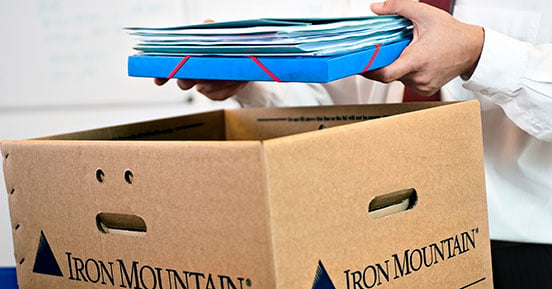Elevate the power of your work
Get a FREE consultation today!
This whitepaper will help you define what your vital records are, understand the risks associated with inadequate preservation and evaluate storage options.

Although they number just a few percent of an organization’s total record population, vital records and how you care for them can have a big impact on your business. These records require special preservation measures—ones that aren’t found in ordinary on- and offsite storage facilities. Whether a legal document, photograph, customer record, X-ray, blueprint, patent, corporate article, or oneof-a-kind object, when it comes to vital records, storage is the single most important factor in determining their useful life.
How do you identify what records are vital to your organization? What measures should you take to ensure their long-term protection? How does the material of which a record is made influence its longevity—and guide your choice of storage solution?
The question remains: Have you done enough to preserve your organization’s vital and irreplaceable five percent? This white paper will help you define what your vital records are, understand the risks associated with inadequate preservation, evaluate storage options, and implement an effective vital records program for your organization.
Protection of vital records may be the least understood— or the least appreciated—area of records management. If you’re reading this white paper, chances are you already know a great deal about managing records. Certainly, this discipline has never been more critical, particularly in light of legislative and compliance requirements, such as the EU General Data Protection Regulation (GDPR); the Sarbanes-Oxley Act (SOX) of 2002; the GrammLeach-Bliley Act (GLBA), also known as the Financial Services Modernization Act of 1999; the Health Insurance Portability and Accountability Act of 1996 (HIPAA); and the growing body of state and local mandates designed to protect information. In addition, new laws have increased the cost and risk associated with legal discovery processes—a particularly worrisome area in today’s litigious world.
And chances are you have devoted significant resources and effort to improving your records management strategy and procedures. But have you done enough?
One area of vulnerability for many organizations is ensuring the accessibility of records. Comprising just five percent of an organization’s total record population, vital records are critical to enterprise operations. They may contain information needed to ensure business continuity during or shortly after a crisis, for example. Or they may document legal or financial status and preserve the rights of an organization’s stakeholders. If vital records are managed properly, your organization is protected. If they aren’t, you’re exposed to risks such as noncompliance, loss of asset value, and high costs associated with restoration and duplication.
“Vital” has a unique meaning when it comes to records. For example, your current checking account balance is a critical piece of information, but it’s dynamic and doesn’t need to be preserved for extended time periods. Therefore, it is not a vital record. Longevity is the fundamental differentiator between vital records and all others. Vital records have enduring value that must be preserved for years or even centuries. Storing them in a box on a shelf somewhere is simply not enough. The preservation process must ensure that vital records remain secure, accessible, and usable over these extreme time frames.
Vital records contain information organizations need to continue operations during or shortly after a crisis. Some document legal and financial status, such as contracts, patents, deeds, X-rays, laboratory notebooks, and blueprints. Others preserve the rights of stakeholders. Still others are one-of-a-kind items with historical significance. Vital records are often physical records, such as paper or film. And, as detailed in the following section, every organization has a uniquely defined set of vital records.
Remember, what’s vital for one organization may not be for another. Use your organization’s mission as a guide for determining which records are truly vital.
Identifying records that are truly vital is the first step in the preservation process– and that determination will differ from organization to organization.
Start with your organization’s mission and use that to guide the process of defining what is vital.
When approaching the process of defining vital records, it’s best to start with your organization’s mission and use that as a guide. After all, you cannot afford to collect, label, and treat everything as vital; you must place your limited preservation resources where they are most needed. So it’s incredibly important to think about the elements that define and embody that mission—and which records will therefore require long-term preservation. Ask yourself the following:
Experience shows that if you don’t take this top-down approach, beginning with examining the mission, you’re at a distinct disadvantage—with little basis upon which to determine what’s important and how to create a plan.
Once you’ve done the difficult work of thinking through your organization’s mission and using that to define which records are vital, tactical decisions about how to protect them are much more straightforward. Your focus should be on minimizing and avoiding the risks associated with inadequate protection of vital records. And the key here is preserving access to, and usability of, your vital records.
Without proper preservation, records degrade over time and may be lost forever. The impact on your organization can be severe. Consider the following risks:
“Without proper preservation, records degrade over time and may be lost forever.”
Once you’ve identified your vital records and know what materials must be preserved, the next step is determining the best way to care for them. Storage is the single most important factor determining the useful life of modern information media. Many organizations use offsite storage for records management. These sites are secure, accessible, and offer the required redundancy. And they are perfectly adequate for standard record retention.
However, when it comes to vital records—records for which long-term survival must be ensured—traditional storage approaches are inadequate. Room temperature storage with unregulated humidity levels does not afford the special protection needed for vital records. As noted earlier, in uncontrolled environments with variable room temperatures and relative humidity levels, paper turns brittle, ink fades, and plastics may degrade quickly. In addition, standard storage does not afford maximum protection from catastrophic loss due to natural or man-made disasters, including fire, floods, tornadoes, and hurricanes. And, in many cases, it does not offer the highest levels of security needed for irreplaceable originals, such as works of art or special documents.
Proper preservation of vital records calls for a storage solution that provides the following highly specialized features:
Done properly, such storage solutions minimize risk by using approaches to preservation that are well understood, documented, and have proven successful time and again.
It is absolutely essential that you measure any vital records storage solution against the prior list. After all, when it comes to that irreplaceable five percent of records that are vital to your organization, it’s an investment you simply cannot afford to overlook.
| Advantages | Disadvantages |
| Improve business continuity with secure, offsite records storage. | Inadequate environmental controls—temperature and humidity levels—don’t offer the protection needed for long-term record preservation and/or protection against the risk of mold and mildew in certain climates. |
| Reduce the costs associated with storing and administering records onsite. | More susceptible to disasters, such as fire, earthquakes, tornadoes, and hurricanes. |
| Provide 24/7 access to records. |
|
May include:
|
| Advantages | Disadvantages |
| All of the advantages of traditional storage solutions, plus:
|
More costly than traditional storage, but that cost must be weighed against the risks associated with the loss of improperly stored vital records. |
When it comes to vital records, every organization has three options:
To develop a successful vital records program—and protect that small percent of records your organization cannot function without—take the following steps:
The lack of a sound vital records preservation program can be a real Achilles’ heel for an organization—exposing it to considerable financial, compliance, and business continuity risks, as well as potential damage to its reputation. There’s also a huge potential to miss out on long-term business opportunities that cannot yet be envisioned.
No one can predict the future, but there’s a strong case to be made for preserving the untapped potential in your vital records. What’s needed is a careful comparison of the business impact and risks from doing nothing to the mitigation costs associated with a well-designed and properly executed vital records management and storage program. By taking a proactive approach to vital records identification and protection, forward-thinking organizations are making a sound investment in the future that can pay off in the decades, and even centuries, to come. Be a visionary: preserve your vital records.
Get a FREE consultation today!


